The HDPE crate market is estimated to be valued at USD 1.4 billion in 2025 and is projected to reach USD 1.9 billion by 2035, registering a compound annual growth rate (CAGR) of 3.0% over the forecast period. The HDPE crate market is experiencing steady growth, driven by the increasing demand for durable, lightweight, and reusable packaging solutions across diverse industries. Growth is being supported by rising adoption in food and beverages, logistics, agriculture, and retail sectors, where robust material handling and transportation efficiency are critical. High-density polyethylene offers strength, chemical resistance, and hygiene compliance, which make it a preferred choice for modern supply chains.
The HDPE crate market is further boosted by the trend towards sustainable and reusable packaging solutions, which reduces environmental impact while improving cost efficiency. Technological improvements in manufacturing processes, including injection molding and blow molding, are enhancing the durability and design flexibility of HDPE crates.
Increasing focus on operational efficiency, traceability, and product protection is reinforcing the adoption of HDPE crates across industrial and commercial applications. As regulatory emphasis on food safety and sustainable packaging intensifies, the HDPE Crate market is expected to maintain sustained growth, driven by the combined benefits of durability, reusability, and operational convenience.
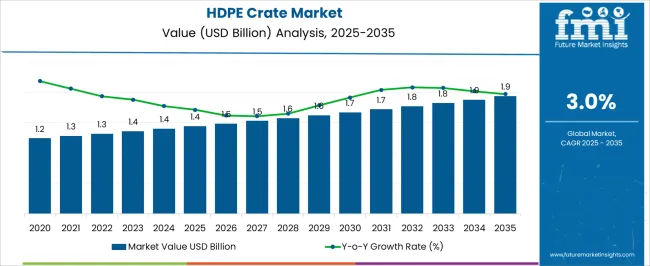
| Metric | Value |
|---|---|
| HDPE Crate Market Estimated Value in (2025 E) | USD 1.4 billion |
| HDPE Crate Market Forecast Value in (2035 F) | USD 1.9 billion |
| Forecast CAGR (2025 to 2035) | 3.0% |
The HDPE crate market is segmented by Packaging Type, Product Type, and End Use and region. By Packaging Type, the HDPE crate market is divided into Sold HDPE Crates and Mesh HDPE Crates. In terms of Product Type, the HDPE crate market is classified into Foldable HDPE Crates, Bottle HDPE Crates, and Box Pallets HDPE Crates. Based on End Use, the HDPE crate market is segmented into Food And Beverages, Dairy, Bakery And Confectionery, Meat & Poultry, Pharmaceuticals, Chemicals, and Others. Regionally, the HDPE crate market is classified into North America, Latin America, Western Europe, Eastern Europe, Balkan & Baltic Countries, Russia & Belarus, Central Asia, East Asia, South Asia & Pacific, and the Middle East & Africa.
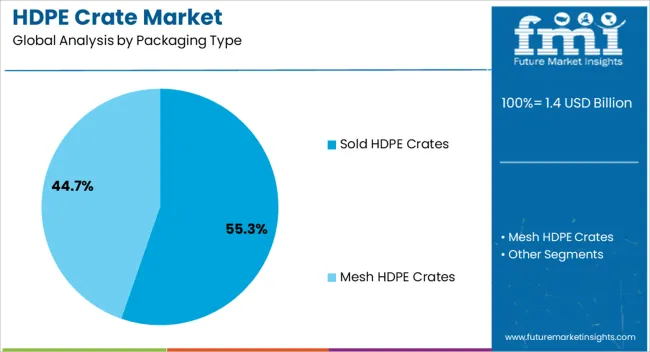
The sold HDPE crates packaging type segment is projected to hold 55.3% of the HDPE crate market revenue in 2025, establishing it as the leading packaging type. This growth is being driven by the preference for ready-to-use crates that require minimal assembly and ensure immediate deployment across logistics, retail, and food handling operations.
Sold HDPE crates provide enhanced structural integrity and uniformity, which helps in maintaining product quality during transportation and storage. The ability to support stacking, secure handling, and integration with automated material handling systems has further reinforced their adoption.
The segment’s popularity is also supported by the ease of cleaning, hygiene compliance, and resistance to chemical exposure, making them suitable for food and pharmaceutical applications As organizations increasingly prioritize operational efficiency, product protection, and regulatory compliance, sold HDPE crates are expected to remain the leading packaging type, driven by reliability, performance consistency, and operational convenience in various industrial and commercial sectors.
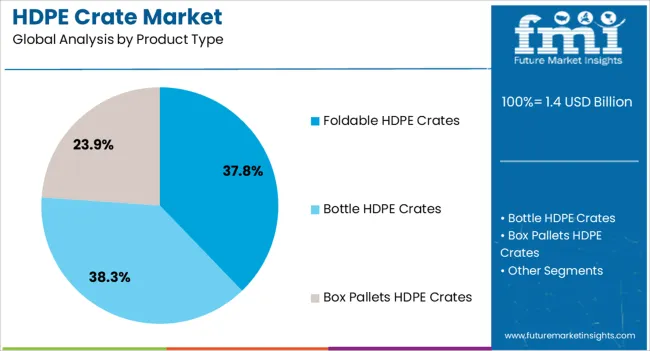
The foldable HDPE crates product type segment is expected to account for 37.8% of the HDPE crate market revenue in 2025, making it the leading product type. Its growth is being driven by the demand for space-saving, reusable, and flexible packaging solutions that optimize storage and reduce transportation costs. Foldable crates provide easy handling and transport while allowing for efficient stacking and compact storage when not in use, which is particularly important for supply chains with limited space.
The durability, chemical resistance, and hygiene compliance of HDPE material enhance their suitability for food, retail, and logistics applications. Businesses are increasingly adopting foldable crates to minimize operational costs, improve warehouse management, and ensure safe product handling.
Continuous advancements in crate design, load-bearing capacity, and foldability features are supporting widespread adoption. As organizations focus on sustainability, cost efficiency, and supply chain optimization, foldable HDPE crates are expected to maintain their leading position as a preferred product type in the HDPE crate market.
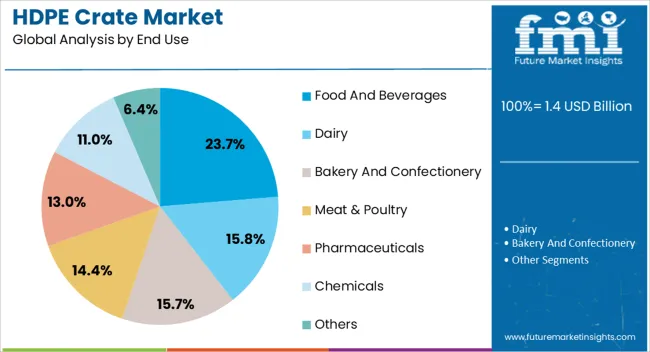
The food and beverages end-use segment is projected to hold 23.7% of the HDPE crate market revenue in 2025, establishing it as the leading end-use category. Growth in this segment is being driven by the increasing demand for safe, hygienic, and durable packaging solutions that protect perishable goods during storage and transportation. HDPE crates are widely adopted due to their resistance to moisture, chemicals, and physical damage, ensuring product quality and compliance with stringent food safety regulations.
The lightweight nature and ease of handling of these crates improve operational efficiency in processing facilities, distribution centers, and retail operations. Businesses are leveraging HDPE crates to streamline supply chain management, optimize space utilization, and minimize product losses.
Rising consumer expectations for fresh and high-quality food products are further supporting adoption As the food and beverage industry continues to expand and emphasize sustainability, hygiene, and cost-effective logistics solutions, HDPE crates are expected to remain a primary choice for this end-use segment, reinforcing its market-leading position.
In 2020, the global HDPE crate market showed a potential worth USD 1.2 billion, according to a report from Future Market Insights (FMI). The HDPE crate market witnessed significant growth, registering a CAGR of 2.20% from 2020 to 2025.
| Historical CAGR | 2.20% |
|---|---|
| Forecast CAGR | 3% |
The HDPE crate market reflects augmenting demand for HDPE crates across various industries, propelled by their durability, lightweight nature, and versatility in storage and transportation applications. As companies sought efficient and sustainable packaging solutions, HDPE crates emerged as a preferred choice, contributing to extending the HDPE crate market.
The HDPE crate market is projected to continue its production with a forecasted CAGR of 3% from 2020 to 2025. The scheduled rate suggests sustained demand for HDPE crates globally, driven by factors including the growth of e-commerce, the expansion of the retail sector, and the anticipated emphasis on sustainable packaging solutions.
The below section shows the leading segment. Based on the product type, the nestable segment is accounted to hold a market share of 49.6% in 2025. Based on end-use, the logistics and transportation segment is accounted to hold a market share of 31.4% in 2025.
Nestable crates are stacked efficiently when empty, as they can be nested together, which helps reduce the required space. Businesses use HDPE crates so that they can streamline logistics operations that help in the reduction of damage to the products, ensuring deliveries on time, thus improving the supply efficiency.
| Category | Market Share in 2025 |
|---|---|
| Nestable | 49.6% |
| Logistics and Transportation | 31.4% |
Based on the product type, the nestable segment stands out, capturing a significant market share of 49.6%. Nestable HDPE crates are favored for their space-saving design, that allowed them to be stacked efficiently when empty and nested together to optimize storage and transportation.
The nestable segment is highly suitable for industries that maximize warehouse spaces and streamline logistics operations. Businesses tend to prioritize efficiency and cost-effectiveness in their supply chain management, and the demand for nestable HDPE crates continued to propel.
Based on end-users, the logistics and transportation segment is accounted to hold a market share of 31.4% in 2025. HDPE crates provide a reliable and durable packaging solution for safely handling and distributing goods.
Such crates offer superior product protection during transit by minimizing the risk of damage or breakage. With the global expansion of e-commerce and the propelling need for efficient warehousing and distribution networks, the demand for HDPE crates is augmented to have a robust surge in the segment.
The table describes the top five countries ranked by revenue, with India holding the top position. India holds a magnified position due to the major usage of HDPE crates in the pharmaceutical industry as it ensures safe and secure delivery of medicines to hospitals, pharmacies, etc.
Forecast CAGRs from 2025 to 2035
| Countries | CAGR |
|---|---|
| United States | 1.8% |
| Germany | 1.5% |
| China | 4.7% |
| Spain | 2.1% |
| India | 6.1% |
The HDPE crate market is primarily used in the retail and grocery industry in the United States. Supermarkets, convenience stores, and retailers widely utilize HDPE crates to store and transport fresh produce, dairy products, beverages, and other perishable goods.
The crates offer durability, hygiene, and ease of handling, making them indispensable for efficiently managing inventory and supply chain logistics in the retail sector.
In Germany, the HDPE crate market is majorly used in the automotive manufacturing sector. HDPE crates are employed for storing and transporting automotive parts, components, and assemblies within manufacturing facilities and throughout the supply chain.
The crates act as damage control and prohibit contamination and moisture, and critical components are ensured to be safe and efficient, thus handling the highly demanding automotive production environment.
The HDPE crate market is predominantly used in the agriculture and horticulture sectors. HDPE crates have extensive applications in storing and transporting fruits, vegetables, and agricultural produce from farms to markets and distribution centers.
The crates offer ventilation, moisture resistance, and durability, facilitating proper airflow and protection for perishable crops during handling, storage, and transit.
The HDPE crate market in Spain is primarily used in the food and beverage distribution industry. HDPE crates serve as essential packaging solutions for the safe and hygienic transportation of packaged food products, beverages, and bottled goods from manufacturers to retailers, restaurants, and consumers.
The crates ensure product integrity, hygiene, and freshness, contributing to the efficient and reliable distribution of food and beverage products across the supply chain.
The HDPE crate market in India is majorly used in the pharmaceutical logistics sector. HDPE crates are employed for storing and transporting pharmaceutical products, medicines, and healthcare supplies, ensuring their safe and secure delivery to hospitals, pharmacies, and healthcare facilities.
Such crates offer protection against contamination, tampering, and environmental factors, maintaining the quality and integrity of pharmaceutical products throughout the distribution process.
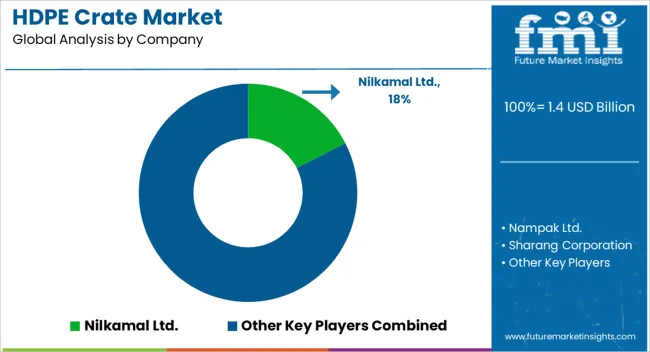
Established manufacturers and suppliers of the HDPE market have a market share through strategic partnerships, product innovation, and expansion into new geographical regions.
Continuous efforts enhance the product offerings by improvising operational efficiency and meeting evolving customer demands that propel competition within the HDPE crate market.
Some of the key developments
| Attributes | Details |
|---|---|
| Estimated Market Size in 2025 | USD 1.4 billion |
| Projected Market Valuation in 2035 | USD 1.9 billion |
| Value-based CAGR 2025 to 2035 | 3% |
| Forecast Period | 2025 to 2035 |
| Historical Data Available for | 2020 to 2025 |
| Market Analysis | Value in USD billion |
| Key Regions Covered | North America; Latin America; Western Europe; Eastern Europe; South Asia and Pacific; East Asia; The Middle East and Africa |
| Key Market Segments Covered | Packaging Type, Product Type, End-use, Region |
| Key Countries Profiled | The United States, Canada, Brazil, Mexico, Germany, The United Kingdom, France, Spain, Italy, Russia, Poland, Czech Republic, Romania, India, Bangladesh, Australia, New Zealand, China, Japan, South Korea, GCC countries, South Africa, Israel |
| Key Companies Profiled | Sharang Corporation; Nampak Ltd.; ENKO Plastics; Gamma Wopla N.V; Chespak (Pty) Ltd.; Kenploy Manufacturers Limited; Nilkamal Ltd.; Plastwell Products |
The global HDPE crate market is estimated to be valued at USD 1.4 billion in 2025.
The market size for the HDPE crate market is projected to reach USD 1.9 billion by 2035.
The HDPE crate market is expected to grow at a 3.0% CAGR between 2025 and 2035.
The key product types in HDPE crate market are sold HDPE crates and mesh HDPE crates.
In terms of product type, foldable HDPE crates segment to command 37.8% share in the HDPE crate market in 2025.






Full Research Suite comprises of:
Market outlook & trends analysis
Interviews & case studies
Strategic recommendations
Vendor profiles & capabilities analysis
5-year forecasts
8 regions and 60+ country-level data splits
Market segment data splits
12 months of continuous data updates
DELIVERED AS:
PDF EXCEL ONLINE
HDPE Containers Market Insights & Growth Outlook 2025 to 2035
HDPE Jug Market
High Density Polyethylene HDPE Market Size and Share Forecast Outlook 2025 to 2035
USA Lubricant Contaminated HDPE Container Waste Market Size and Share Forecast Outlook 2025 to 2035
High Density Polyethylene (HDPE) Bottle Market Analysis - Size, Share, and Forecast 2025 to 2035
Crate Handling Systems Market Size and Share Forecast Outlook 2025 to 2035
Crate Washer Market Analysis - Size and Share Forecast Outlook 2025 to 2035
Crates Market Report - Industry Trends & Demand Forecast 2025 to 2035
Crates And Pallets Packaging Market
Metal Crates Market
Wooden Crate Market Forecast and Outlook 2025 to 2035
Market Share Insights of Wooden Crate Providers
Plastic Crates Market Size and Share Forecast Outlook 2025 to 2035
Reusable Crate Welding Lines Market Size and Share Forecast Outlook 2025 to 2035
Beverage Crate Market Analysis – Size, Share, & Forecast Outlook 2025 to 2035
Competitive Overview of Beverage Crate Market Share
Cardboard Crates Market Size and Share Forecast Outlook 2025 to 2035
Market Share Breakdown of Cardboard Crates Manufacturers
Folding Plastic Crates Market
Returnable Plastic Crate Market Size and Share Forecast Outlook 2025 to 2035

Thank you!
You will receive an email from our Business Development Manager. Please be sure to check your SPAM/JUNK folder too.
Chat With
MaRIA